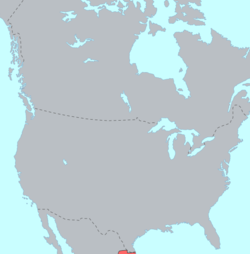- Comecrudosprachen
-
Die Comecrudo-Sprachen (engl. Comecrudan languages) waren eine aus drei Sprachen bestehende Sprachfamilie in Amerika, die im US-Bundesstaat Texas und in Mexiko im Mündungsgebiet des Rio Grande gesprochen wurden. Alle Sprachen sind bereits seit dem 19. Jahrhundert ausgestorben und die einzigen verfügbaren Quellen sind von Missionaren erstellte Wortlisten, deren Qualität weit hinter heutigen Standards bei der Sprachbeschreibung zurückbleibt. Deshalb ist das Wissen über die Grammatik der Comecrudo-Sprachen stark begrenzt.
Die Bezeichnung Comecrudo-Sprachen ist spanischen Ursprungs und ursprünglich pejorativ ("Roh-Esser").
Inhaltsverzeichnis
Gliederung
- Comecrudo †
- Garza †
- Mamulique †
Geschichte der Klassifikation
Die Existenz der Comecrudo-Sprachen als genetische Einheit wurde erst von Goddard (1979) etabliert und gilt gemeinhin als gesichert. [1] Frühere Autoren (Swanton (1915) und Sapir (1920)) rechneten die zu den Comecrudo-Sprachen gehörigen Sprachen anderen Sprachfamilien zu, insbesondere zum Coahuiltekischen und zu den Hoka-Sprachen.
Einzelnachweise
- ↑ Campbell (1997: 145)
Literatur
- Campbell, Lyle. (1997). American Indian languages: The historical linguistics of Native America. New York: Oxford University Press. ISBN 0-19-509427-1.
- Campbell, Lyle; & Mithun, Marianne (Eds.). (1979). The languages of native America: Historical and comparative assessment. Austin: University of Texas Press.
- Goddard, Ives. (1979). The languages of south Texas and the lower Rio Grande. In L. Campbell & M. Mithun (Eds.) The languages of native America (pp. 355-389). Austin: University of Texas Press.
- Goddard, Ives (Ed.). (1996). Languages. Handbook of North American Indians (W. C. Sturtevant, General Ed.) (Vol. 17). Washington, D. C.: Smithsonian Institution. ISBN 0-1604-8774-9.
- Goddard, Ives. (1999). Native languages and language families of North America (rev. and enlarged ed. with additions and corrections). [Map]. Lincoln, NE: University of Nebraska Press (Smithsonian Institute). (Updated version of the map in Goddard 1996). ISBN 0-8032-9271-6.
- Mithun, Marianne. (1999). The languages of Native North America. Cambridge: Cambridge University Press. ISBN 0-521-23228-7 (hbk); ISBN 0-521-29875-X.
- Sapir, Edward. (1920). The Hokan and Coahuiltecan languages. International Journal of American Linguistics, 1 (4), 280-290.
- Sturtevant, William C. (Ed.). (1978-present). Handbook of North American Indians (Vol. 1-20). Washington, D. C.: Smithsonian Institution. (Vols. 1-3, 16, 18-20 not yet published).
- Swanton, John R. (1915). Linguistic position of the tribes of southern Texas and northeastern Mexico. American Anthropologist, 17, 17-40.
- Berlandier, Jean L. (1969). The Indians of Texas in 1830. Ewers, John C. (Ed.). Washington: Smithsonian Institution.
- Berlandier, Jean L.; & Chowell, Rafael (1828-1829). [Vocabularies of languages of south Texas and the lower Rio Grande]. (Additional manuscripts, no. 38720, in the British Library, London.)
- Berlandier, Jean L.; & Chowell, Rafael (1850). Luis Berlandier and Rafael Chovell. Diario de viage de la Comision de Limites. Mexico.
- Gatschet, Albert S. (1886). [Field notes on Comecrudo and Cotoname, collected at Las Prietas, Tamaulipas]. Smithsonian Institute, National Anthropological Archives Ms. no. 297.
- Swanton, John. (1940). Linguistics material from the tribes of southern Texas and northern Mexico. Bureau of American Ethnology, Bulletin, 127 (pp. 1-145).
- Uhde, Adolph. (1861). Die Länder am untern Rio Bravo del Norte. Heidelberg: J. C. B. Mohr.
Wikimedia Foundation.

